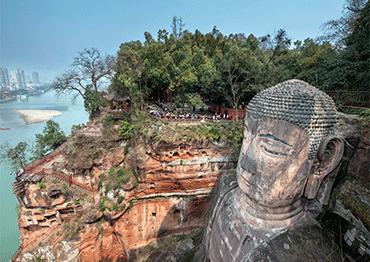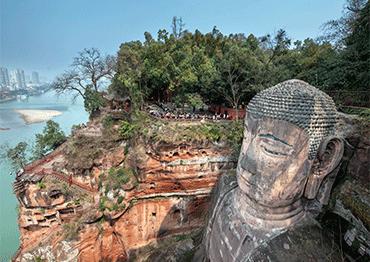Modern China has an eyewatering number of fascinating religious sites for pilgrims, tourists, and locals to enjoy. Moreover, for those who love religious statues, China is home to a shocking number of the world’s tallest and largest Buddhist statues. However, despite their genuine beauty, many of those statues are modern in nature and construction. Even the locations that pertain to a historic legacy have almost all been rebuilt within living memory. However, along a relatively narrow strip of land that constitutes the east of Sichuan province, and the municipality of Chongqing, travelers and pilgrims can find a rich array of Buddhist attractions, including many statues, that are genuinely ancient. Visitors with abundant time should also visit the numerous shrines and temples of Mount Emei, one of China’s holiest mountains. Meanwhile those who can travel further afield can visit the Rongxian Giant Buddha, encased in a fascinating wooden structure to protect it from the elements. However, for visitors who love Buddhist statues, the most important and interesting sites to see are those that have been inscribed by UNESCO on the World Heritage List.
The first, and most famous attraction for those that take an interest in Buddhist history is the Leshan Giant Buddha. This UNESCO world heritage site was carved into the hillside overlooking the confluence of Minjiang River, Qingyi River, and Dadu River in the 8th century. At an impressive 71 meters, it is by far the tallest pre-modern statue in the world. As the statue is embedded within the cliff face, directly at the water’s edge, its true scale can only really be appreciated from the water. Thankfully, there are regular boat tours for visitors to admire this ancient wonder, provided that the river conditions are suitable.
After seeing the statue from the river, it is well worth taking the gentle hike to see the statue up close and personal. The incredible artwork, and the ingenious use of wood and clay for certain features, reveals the engineering and artistic mastery of the craftspeople who worked for decades to complete this masterpiece. Leshan Giant Buddha should not be missed and is worth seeing even on a crowded day. However, if possible, it is well worth visiting out of season on a weekday as it is one of the most popular attractions in all of China.
Atop the mountain, behind the Giant Buddha is a small temple, washrooms, restaurant, and other conveniences. There are a number of walkways, which guide visitors away from the Buddha’s head and leads then towards the Oriental Buddhist Theme Park. Remarkably, despite being physically connected to the Leshan Giant Buddha Park, the Oriental Buddhist Theme Park seems entirely void of the tourist crowds and their mayhem. This may be in part because the Oriental Buddhist Theme Park requires an extra ticket. It may also be because it lacks some of the fame of its ancient neighbor. Then again, it might simply be because the endless bus groups of tourists from Chengdu often aim to visit three or four major attractions on each day trip and therefore lose the opportunity to peacefully enjoy the surroundings of anywhere they visit.
The “theme park” itself is a forested mountainside with a series of sculptures and statues that range in size. The term theme park is rather an unfortunate choice, given its connotations in English, as the park avoids most of the plastic tackiness that can savage one’s enjoyment of parks in China. Instead, one can enjoy a peaceful and leisurely stroll through a forest, and explore some magnificent statues of Buddha in peace, without throngs of tourists destroying the atmosphere. Interestingly the most impressive Buddha of the entire area is arguably not the famous Leshan Giant Buddha, but rather the Pharmacist Buddha within the Oriental Buddhist Theme Park. While it may not be quite as large, and lacks the ancient history of its neighbor, the setting of the Pharmacist Buddha is dramatic enough to elicit genuine gasps of amazement from onlookers. As visitors inspect the grandeur of the Pharmacist Buddha, they discover that behind the Buddha’s left foot there is a small, almost hidden, entrance to a secretive cave network called the Palace of Buddhas. This extensive cave network includes multiple “rooms” of various sizes featuring fascinating reliefs and statues, ranging dramatically in size, scale and scope. The cave network has been cleverly designed to ensure that visitors are never quite aware of what they are about to encounter next. While the carvings within these caves clearly contain modern influence, they are nevertheless a perfect extension to any day out in the Leshan area.
For those that crave the authenticity of genuinely ancient Buddhist culture there are further UNESCO inscribed world heritage landmarks within the region, known as the Dazu Rock Carvings, in the municipality of Chongqing. And though the site is some 100 kilometers from the downtown area, it can be reached by high-speed rail. The carvings cover 75 protected sites, containing over 50,000 individual statues, although they are concentrated in five locations. The carvings date as far back as the 7th century, making some even older than Leshan’s Giant Buddha. The most magnificent of the carvings is at Baodingshan. This location includes a U-shaped valley, where numerous carvings, statues, grottoes, shrines and etchings stretch for over 500 meters. The carvings range from the ornate, to the simple, and from the miniature, to the massive. Many depict classic themes, although the depictions of violence and torture in hell are not for the faint hearted. Perhaps the most magnificent aspect of the carvings is the survival of extensive colored pigment. Visitors exit the area of the carvings through a large temple complex, which serves to remind tourists that the site is not just a location for gawping fascination and social media photography, it is also an important religious location.
There are further rock carvings at Nanshan, Shizhuanshan, and Shimenshan, all classed under the Dazu Rock Carvings World Heritage Site. However, the other famous and popular location to visit is the Dazu Rock Carvings at Beishan. These carvings are possibly less dramatic than those at Baodingshan, however many are older and include fascinating tantric and Taoist themes in addition to the Buddhist iconography. The 300 meters of carvings are protected by wooden roofs, which shelter them from the elements and provide much needed shelter for visitors. Indeed, after exploring so many extensive displays of Buddhist culture, one could be forgiven for craving relaxation after a visit to Beishan. However, the most curious attraction awaits. At the exit, visitors with a sharp eye will notice a couple of trails heading up an adjacent small mountain. Clearly, at some point one needed to pay to access these paths. However, all that remains are the remnants of turnstiles, which are now free. At the top of the small hill visitors come across an ancient pagoda, and two giant Buddhas side by side. While these Buddhas are not the largest, nor the most historic, the fact that they seem to be abandoned, and the absence of other visitors, makes them all the more fascinating.

 Old Version
Old Version

